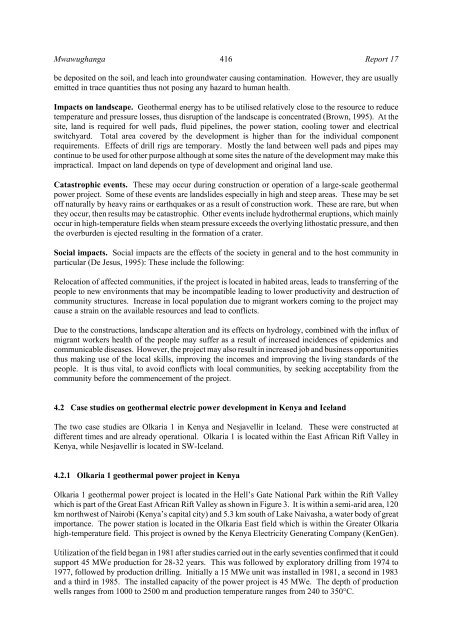comparison of environmental aspects of geothermal ... - Orkustofnun
comparison of environmental aspects of geothermal ... - Orkustofnun
comparison of environmental aspects of geothermal ... - Orkustofnun
You also want an ePaper? Increase the reach of your titles
YUMPU automatically turns print PDFs into web optimized ePapers that Google loves.
Mwawughanga 416<br />
Report 17<br />
be deposited on the soil, and leach into groundwater causing contamination. However, they are usually<br />
emitted in trace quantities thus not posing any hazard to human health.<br />
Impacts on landscape. Geothermal energy has to be utilised relatively close to the resource to reduce<br />
temperature and pressure losses, thus disruption <strong>of</strong> the landscape is concentrated (Brown, 1995). At the<br />
site, land is required for well pads, fluid pipelines, the power station, cooling tower and electrical<br />
switchyard. Total area covered by the development is higher than for the individual component<br />
requirements. Effects <strong>of</strong> drill rigs are temporary. Mostly the land between well pads and pipes may<br />
continue to be used for other purpose although at some sites the nature <strong>of</strong> the development may make this<br />
impractical. Impact on land depends on type <strong>of</strong> development and original land use.<br />
Catastrophic events. These may occur during construction or operation <strong>of</strong> a large-scale <strong>geothermal</strong><br />
power project. Some <strong>of</strong> these events are landslides especially in high and steep areas. These may be set<br />
<strong>of</strong>f naturally by heavy rains or earthquakes or as a result <strong>of</strong> construction work. These are rare, but when<br />
they occur, then results may be catastrophic. Other events include hydrothermal eruptions, which mainly<br />
occur in high-temperature fields when steam pressure exceeds the overlying lithostatic pressure, and then<br />
the overburden is ejected resulting in the formation <strong>of</strong> a crater.<br />
Social impacts. Social impacts are the effects <strong>of</strong> the society in general and to the host community in<br />
particular (De Jesus, 1995): These include the following:<br />
Relocation <strong>of</strong> affected communities, if the project is located in habited areas, leads to transferring <strong>of</strong> the<br />
people to new environments that may be incompatible leading to lower productivity and destruction <strong>of</strong><br />
community structures. Increase in local population due to migrant workers coming to the project may<br />
cause a strain on the available resources and lead to conflicts.<br />
Due to the constructions, landscape alteration and its effects on hydrology, combined with the influx <strong>of</strong><br />
migrant workers health <strong>of</strong> the people may suffer as a result <strong>of</strong> increased incidences <strong>of</strong> epidemics and<br />
communicable diseases. However, the project may also result in increased job and business opportunities<br />
thus making use <strong>of</strong> the local skills, improving the incomes and improving the living standards <strong>of</strong> the<br />
people. It is thus vital, to avoid conflicts with local communities, by seeking acceptability from the<br />
community before the commencement <strong>of</strong> the project.<br />
4.2 Case studies on <strong>geothermal</strong> electric power development in Kenya and Iceland<br />
The two case studies are Olkaria 1 in Kenya and Nesjavellir in Iceland. These were constructed at<br />
different times and are already operational. Olkaria 1 is located within the East African Rift Valley in<br />
Kenya, while Nesjavellir is located in SW-Iceland.<br />
4.2.1 Olkaria 1 <strong>geothermal</strong> power project in Kenya<br />
Olkaria 1 <strong>geothermal</strong> power project is located in the Hell’s Gate National Park within the Rift Valley<br />
which is part <strong>of</strong> the Great East African Rift Valley as shown in Figure 3. It is within a semi-arid area, 120<br />
km northwest <strong>of</strong> Nairobi (Kenya’s capital city) and 5.3 km south <strong>of</strong> Lake Naivasha, a water body <strong>of</strong> great<br />
importance. The power station is located in the Olkaria East field which is within the Greater Olkaria<br />
high-temperature field. This project is owned by the Kenya Electricity Generating Company (KenGen).<br />
Utilization <strong>of</strong> the field began in 1981 after studies carried out in the early seventies confirmed that it could<br />
support 45 MWe production for 28-32 years. This was followed by exploratory drilling from 1974 to<br />
1977, followed by production drilling. Initially a 15 MWe unit was installed in 1981, a second in 1983<br />
and a third in 1985. The installed capacity <strong>of</strong> the power project is 45 MWe. The depth <strong>of</strong> production<br />
wells ranges from 1000 to 2500 m and production temperature ranges from 240 to 350°C.

















